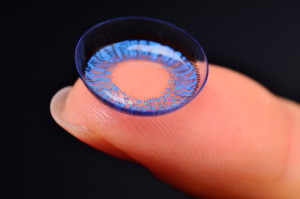A contact lens, or simply contact, is a small, thin plastic or silicone disc shaped medical device worn directly on the cornea of the eye, where they float on a film of tears in front of the cornea. Like eyeglasses, contact lenses are also considered medical devices that help to correct vision, or for cosmetic or therapeutic reasons. They add or subtract focusing power to the eye’s cornea and lens. When used with care and proper supervision, contacts provide an effective and safe way to correct vision offering the best alternative to eyeglasses, depending on the person’s eyes and lifestyle.
 Contact lenses can be categorized in many different ways. They can be separated by their primary function, material, wear schedule i.e., how long a lens can be worn before removing it, and replacement schedule i.e., how long before a lens needs to be discarded. Many types of contact lenses are available and the type of contacts used depends by the person’s particular situation. The most common type of contact lenses currently prescribed is soft contact lenses that are soft and flexible and allows oxygen to reach the cornea. These lenses are made materials that incorporate water.
Contact lenses can be categorized in many different ways. They can be separated by their primary function, material, wear schedule i.e., how long a lens can be worn before removing it, and replacement schedule i.e., how long before a lens needs to be discarded. Many types of contact lenses are available and the type of contacts used depends by the person’s particular situation. The most common type of contact lenses currently prescribed is soft contact lenses that are soft and flexible and allows oxygen to reach the cornea. These lenses are made materials that incorporate water.
Sometimes, contact lenses that are worn daily cause side effects like dry eyes, allergic reactions to contact lens solution, eye and eyelid inflammation and can even lead to sight threatening damage to the cornea if not used with care. According to https://www.contactlenses.co.uk To avoid the risk of infection and risk of contact lens intolerance, it is recommended that contacts should be removed at bedtime.
Antimicrobial coatings on contact lenses have become a latest trend in ophthalmology and could make lens-related infections a thing of the past. These lens are designed to reduce inflammation and cases of infection, might be possible with the use of melimine, developed at the University of New South Wales (UNSW) as an antimicrobial for biomaterials.
The Aloe Hydra System, a new-concept aloe-coated contact lens was presented by Matteo Piovella, MD, at the New Trends in Ophthalmology Symposium by NanoVision. The aloe-coated contact lens provides high hydration and reduces inflammation. The lens is made of a material that allows drug penetration and can, therefore, be used as a therapeutic tool for controlled drug penetration.
Another new trend developed in contact lenses is introducing special contact lenses that can work as braces. These lenses can change the curve in the eye when worn overnight that can help improve eyesight reshaping the eye’s curvature to slow the development of short-sightedness in children.
